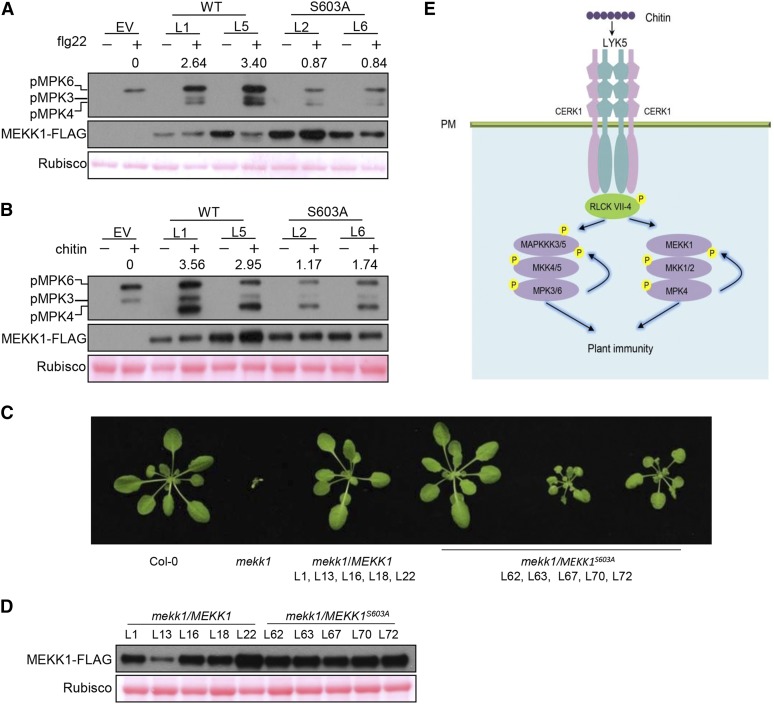Figure 9.
Phosphorylation of MEKK1 at Ser-603 Is Required for the Activation of MPK4 and the Suppression of Autoimmunity.
(A) and (B) Phosphorylation of Ser-603 in MEKK1 is required for flg22- (A) and chitin-triggered (B) MPK4 activation. Seedlings of summ2-8 mekk1 T2 lines complemented with EV, wild-type MEKK1 (WT), or phospho-dead MEKK1S603A (S603A) transgene were sprayed with flg22 (A) and chitin (B) prior to immunoblot analysis with anti-pERK antibody. Numbers indicate arbitrary densitometry units of pMPK4 normalized to Rubisco.
(C) Phosphorylation of Ser-603 in MEKK1 is required for the suppression of autoimmune phenotypes. Wild-type MEKK1-FLAG and MEKK1S603A-FLAG were transformed into heterozygous MEKK1 (+/−) plants. T2 plants homozygous for mekk1 and carrying MEKK1-FLAG and MEKK1S603A-FLAG transgenes were identified by genotyping and immunoblot analysis with anti-FLAG antibody. Plants of the indicated genotypes were scored for phenotypes, and representative photographs are shown. All plants of lines complemented with wild-type MEKK1-FLAG (mekk1/MEKK1) displayed a wild-type phenotype, whereas lines complemented with MEKK1S603A-FLAG (mekk1/MEKK1S603A) displayed a range of phenotypes from wild-type-like (approximately one-third) to partially stunted growth (approximately two-thirds) in individual plants.
(D) Accumulation of MEKK1-FLAG protein in lines shown in (C). Immunoblot analysis with anti-FLAG antibody was performed on mature plants of the indicated lines. Ponceau staining indicates equal loading of protein.
(E) A model for MPK3/6/4 activation triggered by chitin. LYK5 forms a receptor complex with CERK1 for chitin perception, leading to the activation of RLCK VII-4 subfamily members, which subsequently phosphorylate MAPKKK5 Ser-599 and MEKK1 Ser-603. This phosphorylation positively regulates MAPKKK3/5 and MEKK1 activity to activate MKK4/5-MPK3/6 and MKK1/2-MPK4, respectively. The activated MPK3/6 phosphorylate MAPKKK5 Ser-682/692 to further enhance MAPKKK5 activity, and the activated MPK4 phosphorylates MEKK1 to amplify the MAPK cascade.

